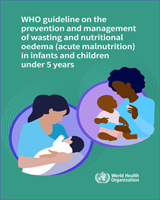The outcomes to the guideline questions can be found in Web Annex A and the sytematic review references can be found in Web Annex B.
A. Management of infants less than 6 months of age at risk of poor growth and development
Admission, referral, transfer, and exit criteria for infants at risk of poor growth and development
In infants less than 6 months at risk of poor growth and development, what are the criteria that best inform the decision to initiate treatment in an outpatient/community setting?
In infants less than 6 months at risk of poor growth and development, what are the criteria that best inform the decision for referral to treatment in an inpatient setting?
In infants less than 6 months at risk of poor growth and development admitted for inpatient treatment, what are the criteria that best inform the decision for transfer to outpatient/community treatment?
In infants less than 6 months at risk of poor growth and development receiving outpatient/community treatment, what are the criteria that best inform the decision for exit from outpatient/community treatment?
Management of breastfeeding/lactation difficulties in mothers/caregivers of infants at risk of poor growth and development
In mothers/caregivers of infants less than 6 months at risk of poor growth and development who are experiencing difficulties with breastmilk intake, which interventions to manage difficulties with breastfeeding/lactation can improve breastfeeding practices and increase breastmilk intake?
Supplemental milk for infants at risk of poor growth and development
In infants less than 6 months at risk of poor growth and development, which criteria best determine if and when an infant should be given a supplemental milk (in addition to breastmilk if the infant is breastfed)?
In infants less than 6 months at risk of poor growth and development meeting the above criteria, what is the most effective supplemental milk (donor human milk, human milk from wet nurse, commercial infant formula, F-75, F-100, or diluted F-100) and for how long should these be given?
Antibiotics for infants at risk of poor growth and development
In infants less than 6 months at risk of poor growth and development, should an antibiotic be routinely given (as per the 2013 guidelines for severe wasting and oedema)?
Interventions for mothers/caregivers of infants at risk of poor growth and development
In mothers/caregivers of infants less than 6 months at risk of poor growth and development, do maternal nutritional supplementation and/or counselling and/or maternal-directed mental health interventions improve infant outcomes?
B. Management of infants and children 6–59 months with wasting and/or nutritional oedema
Admission, referral, transfer, and exit criteria for infants and children with severe wasting and/or nutritional oedema
In infants and children 6–59 months, what are the criteria that best inform the decision to initiate treatment in an outpatient/community setting for wasting and/or nutritional oedema?
In infants and children 6–59 months with wasting and/or nutritional oedema, what are the criteria that best inform the decision for referral to treatment in an inpatient setting for wasting and/or nutritional oedema?
In infants and children 6–59 months admitted for inpatient treatment of wasting and/or nutritional oedema, what are the criteria that best inform the decision for transfer to outpatient/community treatment?
In infants and children 6–59 months receiving outpatient/community treatment for wasting and/or nutritional oedema, what are the criteria that best inform the decision for exit from outpatient/community treatment?
Identification of dehydration in infants and children with wasting and/or nutritional oedema
In infants and children with moderate or severe wasting or oedema, how can dehydration be identified?
Rehydration fluids for infants and children with wasting and/or nutritional oedema and dehydration but who are not shocked
In infants and children with moderate or severe wasting or oedema and dehydration but who are not shocked, what is the effectiveness of standard WHO low-osmolarity ORS compared with ReSoMal during inpatient care?
Hydrolyzed formulas for infants and children with severe wasting and/or nutritional oedema who are not tolerating F-75 or F-100
In infants and children with severe wasting or oedema who are not tolerating F-75 or F-100, what is the effectiveness of hydrolyzed or lactose-free formulas during inpatient care?
Ready-to-use therapeutic food for treatment of severe wasting and/or nutritional oedema
In infants and children 6–59 months with severe wasting and/or nutritional oedema, what is the optimal quantity and duration of RUTF?
Dietary management of infants and children with moderate wasting
In infants and children 6–59 months with moderate wasting across settings and contexts, which children require specially formulated foods (SFFs); also what is the effectiveness of SFFs versus non-specially formulated food interventions versus other approaches?
In infants and children 6–59 months with moderate wasting, what is the appropriate dietary treatment in terms of optimal type, quantity, and duration?
Identification and management of wasting and nutritional oedema by community health workers
In infants and children with wasting without co-morbidities, what is the effectiveness of the identification and management of wasting by community health workers (in community settings)?
C. Post-exit interventions after recovery from wasting and/or nutritional oedema
Which infants and children at risk of poor growth and development or with moderate or severe wasting or oedema require post-exit interventions?
In infants and children at risk of poor growth and development or with moderate or severe wasting or oedema meeting the above criteria, which post-exit interventions are effective?
D. Prevention of wasting and nutritional oedema
In communities with infants and children up to five years old at risk of wasting and nutritional oedema, what community characteristics increase or mitigate risk of wasting and nutritional oedema for individual children?
In communities with infants and children up to five years at risk of wasting and nutritional oedema, what is the effectiveness of interventions for prevention of wasting and nutritional oedema?
In communities with infants and children up to five years at risk of wasting and nutritional oedema, what is the effectiveness of population-based interventions compared to targeted interventions for primary and secondary prevention of wasting and nutritional oedema?

